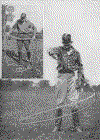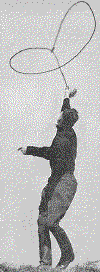By Bernard S. Mason

22. Arrangement for the Flat Spin.
23. The Flat Spin.
Having mastered the body spin and gotten the "feel" of the spinning rope, we are now in position to take up the flat spin, which is in reality easier than the other and will doubtless be learned in a few minutes. It consists of spinning the rope in front of the body as in Picture 23.
The same rope used for the body spin is ideal for the flat spin. Arrange the rope as in Picture 22. Note that the noose is quite small, the end of the rope extending over to the left hand.
Keeping the left hand practically in place, flop the noose over with the right hand so that it is parallel with the ground and in the same motion give it a spin from right to left.
Let go of the loop with the left hand, holding on to the end only. This initial spin which you give it must be a circular motion-your hand must cut a circle in the air of about the same motion-your and shape which the spinning loop is to have.
It is as if you took hold of a prostrate bicycle wheel and gave it a spin. But after you once get it going it is all a wrist motion.
When you can do the flat spin nicely with the right hand, pass the spinning rope to the left hand and continue until you can do it equally well with either hand.
In the flat spin, the rope can, of course, be easily spun in either direction. As described above, it is spun counterclockwise. With a little practice you can make it spin in the opposite or clockwise direction.
JUMPING IN

24. Ready to Step
If we are clever enough, now that we have learned the flat spin, it is possible to step into the spinning noose, as illustrated in Picture 25. But you must step at just the right moment or the stem will hit you as it spins around. The time to step is just as the stem starts toward you-by the time you have jumped it will be past you and out of the way.

25. Stepping In
In Picture 24 the stem is in just the right position to jump -it is away from the spinner and just starting toward him. Picture 25 shows where the stem is by the time he has stepped.
The trick is not to jump up in the air and pull the spinning noose toward you-that would break the spin. Instead, you must step into it. The spinning rope remains m the same place-you merely step over into it.
Once inside, raise the right hand overhead and do the body spin.
A rope 17 or 18 feet long may be a little handier in learning this trick and the one that follows.
JUMPING OUT
Having started with the flat spin and jumped into it, the next trick is to step out. This is done by dropping the spinning noose to the ground and stepping back out of it.
In doing the body spin, just as the stem passes your right shoulder, drop the noose to the ground by lowering your right hand to near the belt, and immediately step backwards and over the spinning rope, picking up the spin in front of you again.
After you have stepped out of the noose, the rope will be spinning in exactly the same place as before-the noose is not moved forward, rather you yourself step backward and out of it. Now you can step right back into it again.
In learning these tricks of jumping out and in it is best to practice at first on a smooth floor, but eventually you will be able to do it without letting the noose touch the floor.
THE JUGGLE

26. The Juggle,
Going Up.
The juggle is one of the most picturesque and fascinating of the rope spinning tricks, both to the spinner himself and to the spectators. The juggle is the body spin except that the spinning noose is dropped to the floor, then raised up overhead as far as it will go, pulled down to the floor again, then up again, and so on, in rapid succession. It is often a little difficult for beginners to learn, largely because they do not know the details of the trick, but by following these instructions it should be easy. Picture 26 shows the juggle on the way up.
Using the same 20 foot rope with the wired honda with which the preceding tricks were done, get the body spin going nicely, and then start lowering and raising it, very slightly at first. This lowering is done entirely by the shoulder. Keeping your forearm straight overhead as in the body spin, lower the arm a little at the shoulder just as the stem passes the right shoulder, then raise it as high as you can reach. Keep this up until you can raise and lower your arm at the shoulder slightly without breaking the spinning noose.
When you have accomplished this much we can try the real juggle. Just as the stem is passing your right shoulder drop the noose to the floor as in handshaking, but instead of changing hands give the rope a spin there and raise it right up again, bringing the stem up behind the left shoulder. In raising your hand up reach as high overhead as possible, then drop the noose to the floor again.
The rope must spin around three times on each trip up or down once near the floor, once while passing the waist, and once overhead. We must keep time with the spinning noose in raising it; we cannot rush it-it must have plenty of time to do the three spins at a steady uniform rate of speed. It is well to count while learning-one for the lower spin, two for the one around the waist, three for the high one and four for the middle one going down. Take it easy and do not be discouraged-it will come to you soon. When the noose is at its lowest point, be sure to give it a spin there before you start to raise it.
When you can raise the noose up and down, you will want to get a new rope better adapted to the trick and with which you can do a more spectacular juggle. Secure 25 feet of No. 12 spinning rope equipped with a metal honda, obtainable through your dealer or a manufacturer of spinning ropes. The rope is fitted around the honda and wired as in
Figure D, Picture 15. Now try the juggle and see the change-the metal honda gives it weight and you can raise and lower the loop in rapid succession and throw it as high overhead as the stem will permit. This same rope is what is needed for some of the tricks we are going to learn later (particularly the skip). Do not attempt to convert the 20 foot light-honda rope into a juggle rope by adding a heavy honda ; you will want that rope for the many other tricks for which it is adapted.
OVERHEAD AND DOWN
Here is a trick which to the spectator seems extremely difficult and which sounds most difficult to the reader, but as a matter of fact it is not especially so. It consists of tossing the spinning noose up over the head, and down in front of the body, keeping it spinning there.

27. Up and Over
Start from the flat spin in front of you and get the noose spinning rapidly. Step into it as you did in Picture 25 and just as you do so raise your arm up quickly, tossing the noose away up over your head as in Picture 27. Look up at it as the roper is doing in the picture. Note where the stem is and give it one spin up there, then throw it down on the floor in front of you. Instantly pick it up and keep the spin going. After a few times you will be able to catch the loop in the air in front of you and not let it hit the floor.
If you give it a good spin as you step into it, and keep your eye on it over your head, giving it a spin up there, you will have no difficulty in mastering this one and you will have learned a head-line trick.
While doing the body spin you can, of course, toss the rope up over your head as in the juggle and down in front of you.
JUGGLING IN HEAD FIRST
Get the flat spin going rapidly in front of you, raise the noose up above the level of your head, step under it and pull it down into the body spin. When you are doing the flat spin in front of you, your hand holding the stem is above the noose, of course. As you raise the noose you must pull your hand with the stem quickly around and under it. This is a more difficult trick and requires practice.